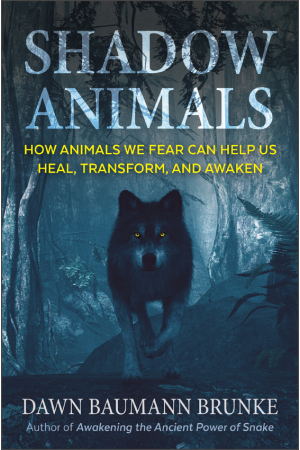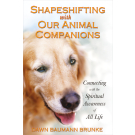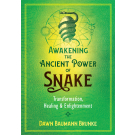Shadow Animals
How Animals We Fear Can Help Us Heal, Transform, and Awaken
- Pages: 320
- Book Size: 6 x 9
- ISBN-13: 9781591434573
- Imprint: Bear & Company
- On Sale Date: November 8, 2022
- Format: Paperback Book
- Illustrations: 231 b&w illustrations
As Dawn Baumann Brunke explains, the animals we fear or dislike can help us to recognize our Shadow: the hated, abandoned, judged, and denied aspects of ourselves. She explores the lessons of a wide variety of shadow animals and presents thirteen animal-inspired exercises designed to examine, embrace, and integrate our shadow selves.
• Explores the lessons of a wide variety of shadow animals, including snakes, rats, bats, and spiders, as well as those that only seem shadowy to some, such as dogs, cats, birds, and horses
• Looks at the elements of the psyche each shadow animal represents and presents thirteen animal-inspired exercises designed to examine, embrace, and integrate our shadow selves
We often project qualities onto animals that we don’t wish to admit in ourselves. Thus, snakes are evil, spiders are creepy, rats are dirty, and so on. As Dawn Baumann Brunke explains, the animals we fear or dislike can help us to recognize our Shadow: the hated, abandoned, judged, and denied aspects of ourselves. As teachers and guides, shadow animals can help us to reclaim the inner strengths, abilities, and wisdom that we have forgotten or disowned.
Brunke explores the lessons of numerous shadow animals, including those that many think of as shadowy, such as snakes and bats, as well as those that only seem shadowy to some, such as dogs, cats, birds, and horses. Though shadow animals may initially appear frightening, they offer profound healing and expert guidance in helping us identify, learn from, and embrace our shadow selves. Brunke explains how shadow animals represent unexamined elements of the psyche--from secret fears and suppressed emotions to unacknowledged prejudices and repressed trauma. She presents thirteen animalinspired exercises, each uniquely designed to help us find and better understand the lost, wounded pieces of our psyche.
Presenting an animal-centered guide to shadow work, Brunke reveals how shadow animals protect and advise, challenge and encourage, inspire and offer support to the spiritual adventure of enlightenment as we awaken to who we really are.
From Chapter 1: Arachnophobia
Shortly after deciding to write this book, I witnessed the disturbing intensity of arachnophobia.
I was descending a stairwell in a medical building when I heard a shout from below. “Stop, stop! Please help!” screamed a woman, clearly in distress. Racing down the stairs—was this an assault? an abduction?—I turned 180 degrees to descend the second flight of stairs into the lobby.
Frozen in a hunched position, right hand extended with an accusing finger pointing downward, was a middle-aged woman shrieking loudly, “Someone kill it, please!” Just then, a young man bolted from the lobby coffee shop. Halting in front of the woman, he raised his foot high above the dark, dime-sized object of her terror: a spider.
“No!” I cried, rushing toward them, attempting to intervene. I could easily scoop up the spider and relocate it to a non-offending area of the lobby.
But it was too late. Down came the young man’s boot, making an audible stomp on the hard tile floor. As if to make sure the spider was extra-dead, the man twisted his foot—one, two, three times—grinding the tiny spider’s body into the cold beige tile.
Disaster averted (for the woman, but not the spider), the young man turned to leave.
“I have a terrible spider phobia,” said the woman, still frozen to the spot.
The situation seemed overly dramatic: the shrieking woman, the exaggerated stomping, grinding, and killing of the beastly spider. My adrenaline was tweaked and my frustration level high as I made my way to the front door. “Idiots,” I muttered under my breath.
Hours later I realized that I had lost a perfect opportunity to learn more about arachnophobia. I could have engaged the woman, attempted to understand how she felt and why. On further contemplation, I recognized the scenario had also exposed some of my own Shadow. I knew then that I would be facing some deeply personal judgments and prejudices on this journey to better understanding the fear and power and importance of shadow animals in our lives.
SPIDER FEAR
Arachnophobia is a learned phobia, mostly influenced by cultural beliefs and experience. Having been bitten by a spider or unnerved by walking into a spider’s web gives rise to personal fears. That spiders are commonly depicted as scary and threatening in our society reinforces the fear. Add to that a disgust response to multiple eyes and hairy legs, fast movements, sticky webs, and a heaping dose of media predilection to display dramatic spider bites or cast spiders as villains in films, and it is easy to see why spiders have such a bad rap in Western culture.
As with treating most phobias, the trick is to shift fear to curiosity. Because arachnophobes usually don’t know much about spiders, they tend to believe the worst. But a learned set of beliefs can be unlearned and replaced with new, factual understanding. Treatments that combine education and experience thus generally work best, for the more we know about spiders, the more interesting they become. And when agitation yields to amazement, the more likely we are to release irrational fears. An impressive 90 percent of those seeking treatment for arachnophobia show clinical improvement in anxiety.
THE SHADOW SIDE OF SPIDER
If spiders present so little of an actual threat to our survival, why do we fear them so much? Shadow animals represent that which we repress, disown, or judge in ourselves. Is it possible that tiny Spider possesses some very big medicine—something so powerful that nearly a third of all humans don’t want to see or even think about it?
The first spiders scurried over the earth 4 million years ago. But it took another 1 million years for them to become successful as the clever arachnids they are today. Aeronauts, architects, designers, divers, weavers, and engineers—spiders not only astonish and mystify, but are incredibly diverse and accomplished.
Some stalk, some hunt with bolas, some throw nets, some wait in burrows, and some use pheromones to catch their prey. No matter how they do it, all spiders are predators—skillful, calculating hunters that know exactly how to use their talents to fulfill their needs.
While almost all spiders are venomous, very few are dangerous to humans. Spider venom is not designed to harm large creatures such as ourselves, though it can sometimes trigger an allergy, cause pain, illness, or in very rare cases death. With the development of antivenins, however, death by spider bite rarely occurs anywhere in the world, especially in North America.
Most spiders are delicate and nonaggressive. While they generally avoid human activity, they are nonetheless incredibly beneficial to us. By eating vast amount of insects—aphids, fleas, roaches, mosquitoes, and more—spiders help the world to maintain ecological balance.
These are facts. But in the throes of terror, facts are forgotten. In exploring shadow animals throughout this book, detective work is key. There is no one-size-fits-all answer as to what wisdom or special teaching Spider holds for you. Rather, we each need to deepen our focus, consult our feelings, question ourselves, and follow the clues.
There is an art to feeling what resonates within. Breathe deep; sink down; listen, sense, intuit. We need to be patient and allow our curiosity to open us. By paying attention to feelings, we can sense when something is not quite right or gives us a queasy little tug. That is our subconscious whispering, Yes, look here—what’s this uncomfortable feeling? By trusting ourselves to follow such clues, we begin to discover more about who we are.
SPIDER’S SECRET SKILLS
So, what is it about Spider that really bothers you?
All those eyes! All those legs—so hairy and fast! And those fat, squishy bodies, too!
Long ago, before we were squeamish about spiders, we were enthralled. The ancients recognized Spider as a master of creation, communication, and cosmic design. Producing magical threads from its body, patiently joining one silken strand to another, weaving a unified pattern of wholeness, Spider both forms and reveals the universal tapestry of life. Positioned in the center of their webs, eight long legs splayed forth, multiple pairs of eyes gazing in all directions, spiders were once viewed as mystical creatures that guarded the secrets of sacred knowledge.
All spiders have eight legs (an easy way to distinguish them from six-legged insects), most have eight eyes (though some have six, four, two, or none at all), and many have a body divided into two segments that resemble a figure 8. This is why ancient peoples also associated Spider with the lemniscate, the symbol for infinity and the endless flow of energy.
Venerated in countless myths and legends, Spider creates the universe, initiates the flow of cosmic order, and oversees the divine plans of creation. So too does Spider inspire poets and artists and offer wise counsel to kings and rulers throughout the ages.
In ancient Sumeria, Uttu—the celebrated goddess of weaving—was envisioned as a spider creating a web. Both Mayan goddess of procreation (Ixchel) and Egyptian goddess of hunting (Neith) were associted with spiders. And in India, Spider is linked to the great goddess Maya, the weaver of illusion and reality, reminding us that things are not always what they seem, nor all as it appears to be.
In some myths, Spider is the guardian and keeper of words. By spinning designs upon her web, she creates the primordial alphabet—the roots of written communication—teaching humans how to record their thoughts and share knowledge with others, both at a distance and through time.
In the Native American world, Grandmother Spider spins the great Web of Life, linking past and future, connecting all beings in her creation. Weaving loose threads into a living work of art, Spider not only designs the plan of existence, but awakens our creativity and intuitive ability to discern connections.
Spider reminds us that as we are all part of the eternal web of creation, we can access ancient wisdom. At the same time, Spider reveals the limitless ongoing possibilities of creation and teaches us how to spin our thought-webs (our plans, ideas, dreams) to bring us what we need.
Spiders are patient and persistent. A Scottish legend notes that when Robert the Bruce was badly defeated in battle against the English in the early 13s, he retreated to a cave where he noticed a spider building its web. Day after day, the spider failed to secure its threads on the damp walls or, having secured several threads, had them carelessly brushed away. When the spider finally succeeded in constructing its web, the king of Scots recognized the power of tenacity and perseverance. Revitalized by Spider’s lesson of persisting even after failure, he rallied his troops and won independence for Scotland.
THE TWO SIDES OF SPIDER
Like many shadow animals, Spider is at home in the paradox of in-between. Uniting strength and sensitivity, elegance and simplicity, creation and extermination, Spider balances the seen and unseen.
For some, the appearance of a spider heralds breakthrough and completion. On the day I finished writing my first book about animals, a spider descended from a thread upon the ceiling and hovered before my eyes. While I didn’t know what this meant, I felt it as a reassuring sign. With every following book, Spider has appeared to me soon after I finished. At first I felt Spider was cheering me on, but as I later learned of Spider’s association with words and writing, I deepened in appreciation for the larger significance of Spider’s appearance.
WHAT CAN WE LEARN FROM SPIDER?
In ancient Greece a noblewoman named Arachne was celebrated as a weaver. So spectacular were her creations that Athena, goddess of wisdom and the arts, challenged her to a competition. When Arachne created the perfect tapestry, Athena cursed her and poor Arachne hung herself. With later regret and humility, Athena brought Arachne back to life as a spider—the original arachnid—to be acknowledged forevermore as the most accomplished weaver in the world.
As a master weaver, Spider summons design and integration. Spider reminds us that all we envision and do in the world is part of what we create and that all aspects of our life—and all life—are linked and Spider’s elegant web interrelated. Spider can thus help us to align our thoughts, discern connections between ideas, and more consciously design our life as we spin our path and weave our reality.
By working with Spider, we can learn to unravel patterns that frustrate or hold us in knots. Spider can help us to bring together disparate threads—to recover lost selves, for example, or recall forgotten aspects of the past. By contemplating the various threads of our web, we can discover viewpoints we had not considered or connections we did not see. Webs do not have to ensnare or tangle us; they may offer a means to see the larger whole and connect with others in unexpected ways.
Spider reminds us to hone our receptivity, pay attention to subtle details, and feel the web of life supporting us. With patience, we can better weave our reality-web into one that helps us achieve our goals and appreciate our life’s design.
ASKING QUESTIONS, FOLLOWING THREADS
When people say they hate spiders what they often mean is that they fear spiders. For many of us, it’s easier to hate than admit fear. And yet that’s what this book is all about: facing our fears, whatever they may be. What does Spider evoke in you? What is it that you fear so deeply in yourself that you project hatred onto spider?
To uncover any shadow animal’s teaching, you might begin by considering and describing your fears. Sketch them or paint them; dream them or dance them out of your body. Like a spider creating a web, throw out your foundational thread of fear and watch where it lands and what form it takes.
To discern Spider’s teaching can be simple and elegant: follow a strand and see where it takes you. Look for connections; sense the deeper links. By trying different things, we find what doesn’t work and what does.
Like all shadow animals, Spider can help us to discover that which is hidden, forgotten, judged, or disowned. If the thought of Spider brings uncomfortable or uneasy feelings, we have only to look at the web of self. Which of our threads quiver with tension because they are stretched too tight? Which are too loose or need repair? To create a strong web, release what does not work and reinforce what does.
Spider reminds us to consider multiple angles and viewpoints in order to be more conscious of the interconnections in our web.The Cat, the Snake, and the Shadow
A Short Guide to the Shadow
Animal Teachers
Shadow Animal Teachers
Working with the Shadow
Shadow Animals
1 Arachnophobia
Exercise: Spider’s Web of Intrigue
2 Hidden Treasures
Exercise: Rat’s Treasures, Three Ways
3 Suspense and Suspension
Exercise: Be-ing with Bat
4 The Knower of Secrets
Exercise: That Cat--It’s Just a Story We Are Telling Ourselves
5 Trust That Turns
Exercise: Sitting with Dog
6 Scapegoat
Exercise: Reclaiming Our Projections with Goat
7 Nightmare
Exercise: Meeting the Night Mare
8 The Birds
Exercise: Becoming Bird
9 That Which Swarms, Stings, Bites, Burrows, and Invades
Exercise: What’s Bugging Me?
10 What Lurks Below
Exercise: Exploring the Deep Psyche with Shark
11 Metamorphosis
Exercise: Frog’s Mirror Meditation
12 The Fear of Knowing Who We Are
Exercise: Continuing the Quest with Snake
13 The Most Dangerous Animal of All
Exercise: A Celebration of Selves
Acknowledgments
Notes
Bibliography
Index
“Shadow Animals is a beautifully written, profound, and timely book. Brunke skillfully guides us to explore the shadow aspects of ourselves that we project onto animals. With helpful, practical exercises, she reveals how to reclaim those repressed or rejected aspects of ourselves and how to see the animals we once feared as teachers, guides, and healers. This book is particularly valuable given the increasing polarization in our world. By seeing and integrating our shadow aspects, we move toward wholeness, coming back into right relationship with ourselves, each other, and all sentient beings on our planet.” Heather Ensworth, Ph.D., clinical psychologist, astrologer, and author of Finding Our Center
“Shadow Animals focuses on your waking and dreaming animal connections, providing practices to uncover the profound treasures and transformative insights waiting there. Read this when you feel ready to go deeper into your psyche and return to the nature of nature. Highly recommended!” Robert Waggoner, author of Lucid Dreaming: Gateway to the Inner Self
“Brunke’s Shadow Animals is a tour de force. Using the world’s ancient mythologies and folktales to explore modern humanity’s shadow, or hidden self, we learn from rats, bats, wolves, spiders, horses, and many other horned, hoofed, clawed, and winged creatures that can arouse fear in us. Sharing exercises, multicultural stories, and dream translations, Brunke’s book holds a mirror to our psyche, gifting the reader access to the hidden, wounded, or shadow self that resides ‘in the subterranean levels of the collective psyche.’ A remarkable book, Shadow Animals shows how to respect and treasure these fascinating nonhuman beings, as they become our allies, teachers, protectors, and healers guiding us to wholeness on our shared journey home.” J. Zohara Meyerhoff Hieronimus, D.H.L., author of White Spirit Animals: Prophets of Change
“Shadow Animals is a fascinating book that beautifully sheds light on the animals that help us to tap into fear-based emotions and the powerful role they play in our own inner transformational journeys. Dawn explains how each of these animals is in fact a bearer of light that has intentionally crossed our path to bring us their unique soul-healing medicine. She provides a rich and detailed history of the most common fear-triggering animals, their message and gift for you, and exercises to gently induce deep healing, safety, and peace. Shadow Animals is an important and muchneeded book that I highly recommend!” Tammy Billups, author of Animal Wayshowers, Animal Soul Contracts, and Soul Healing with Our Animal Companions
“A compelling read that makes you look at yourself and the relationships you have with your animals. Shadow Animals makes you delve a little deeper than normal, think, and then heal.” Diane Budd, author of Energy Medicine for Animals
"I suspect anyone reading this has shared an intensely close relationship with an animal. Those of us who have wanted to delve more deeply into those relationships on spiritual and sacred levels will find the author, an internationally recognized soul healer, to be a warm and compassionate guide Readers who are skeptical about metaphysics and spirituality can read Animal Wayshowers for the stories alone, but they might find themselves opening to a different world view. Others already in tune with the principles Tammy expounds will find confirmation. My advice to all readers, however, is to read this book with an open mind and an open heart." Sally Rosenthal, Best Friends Animal Society
“A spirited and original contribution to shadow work, showing us how our buried histories and childhood fears take shape in our feelings and phobias around animals. . . . Studded with precious vignettes from mythology and folklore . . . stocked with simple and effective meditations and exercises, Shadow Animals is a marvelous addition to the literature of shadow work and inter-species communication. Highly recommended.”
--ROBERT MOSS, author of The Secret History of Dreaming
We often project qualities onto animals that we don’t wish to admit in ourselves. Thus, snakes are evil, spiders are creepy, rats are dirty, and so on. As Dawn Baumann Brunke explains, the animals we fear or dislike can help us to recognize our Shadow: the hated, abandoned, judged, and denied aspects of ourselves. As teachers and guides, shadow animals can help us to reclaim the inner strengths, abilities, and wisdom that we have forgotten or disowned.
Brunke explores the lessons of numerous shadow animals, including those that many think of as shadowy, such as snakes and bats, as well as those that only seem shadowy to some, such as dogs, cats, birds, and horses. Though shadow animals may initially appear frightening, they offer profound healing and expert guidance in helping us identify, learn from, and embrace our shadow selves. Brunke explains how shadow animals represent unexamined elements of the psyche--from secret fears and suppressed emotions to unacknowledged prejudices and repressed trauma. She presents thirteen animalinspired exercises, each uniquely designed to help us find and better understand the lost, wounded pieces of our psyche.
Presenting an animal-centered guide to shadow work, Brunke reveals how shadow animals protect and advise, challenge and encourage, inspire and offer support to the spiritual adventure of enlightenment as we awaken to who we really are.
DAWN BAUMANN BRUNKE is an animal communicator and dream enthusiast who has led workshops and offered animal consultations for more than 20 years. Her many books include Animal Voices, Shapeshifting with Our Animal Companions, The Animal Wisdom Tarot, Dreaming with Polar Bears, and Awakening the Ancient Power of Snake. She lives in Alaska.











